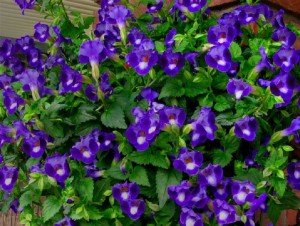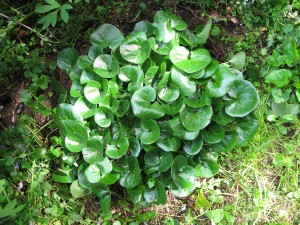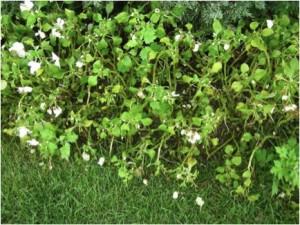Shade Annuals
Last fall a reader alerted me to the fungal disease that has devastated that wonderful shade annual, impatiens, throughout much of New England. The disease, called impatiens downy mildew, will be a problem again for most gardeners this year. Any garden that had the disease last year will have it again this year – even our coldest winters will not cleanse the soil of it. I wish I had known about it sooner, as prompt removal of affected plants may stop the spread of the disease. So if you did not have the disease last year, watch your plants carefully this year and bag and dispose of any diseased plants promptly.
Impatiens downy mildew symptoms are these: yellowing of leaves, then a limp appearance, as if it needs to be watered. Next comes a downy white fungal growth on the undersides of leaves. Then leaves and flowers drop, leaving just a stem with a few leaves on top – as if slugs had eaten the leaves. I have read that if you don’t plant impatiens in a site that has had the disease for a year or two, the soil may become free of disease. But I wouldn’t count on it.
There are two related plants that will thrive in shade or part shade and that are not susceptible to the mildew: New Guinea impatiens and SunPatiens, which is a trademarked hybrid. SunPatiens is advertised as good for part sun to sun – but not deep shade. But it is being marketed as a replacement of impatiens. I wonder if it will be able to bloom as vigorously as our old favorite in full shade. Both are generally sold in individual pots for around $5, quite an upgrade from a six-pack for $3.50 or so that I was accustomed to paying for impatiens in past years.
Another plant that is being touted as a replacement for impatiens is Torenia. I spoke to two landscapers who have used Torenia in past years and say that it is nice enough, but it will not satisfy impatiens-lovers. I’ve heard that it does not have as many blossoms per plant, generally, and is often available in just a few colors – shades of blue and purple, and in white. However, I have found it for sale in multi-packs in a few places and did find one nursery with 4-packs that listed rose, magenta, lemon drops and white as colors available.
I have used bedding lobelia as a nice shade annual, though in my experience it wants a little sun or filtered sun. I love the intense blue that it often displays, though it is available in other colors, too. I started seeds indoors back on April 17, a mix called ‘Cascade of Color’ that promised blue, blue with a white eye, lilac, red, ruby and white.
Right now my lobelia seedlings are only 2 inches tall but I assume they will take right off when I separate them and get them in the ground. The only problem with a mix like that is that one cannot determine what color any given seedling will be – unless you wait for them to bloom in the pot. And, when I read the seed packet (from Botanical Interests) just now, I see that this variety is advertised for full sun. I have plenty, so I’ll try some in shade, too.
So what else can we do to provide color in shade? Try some perennials. Granted, most only bloom for 1 to 3 weeks, but if you select plants with good foliage they can be a joy all summer. I love European wild ginger (Asarum europaeum) for its very glossy dark green leaves. It forms a nice expanding clump, even in dry shade with competition from tree roots. The blossoms are hidden beneath the foliage, but it doesn’t matter to me. This is a great shade plant. I plant them in clumps of three about 18 inches from center to center.
Then there is bigroot geranium (Geranium macrorhizum). Not to be confused with your mom’s red geraniums (which are technically not geraniums at all), this is a nice spreading plant that thrives in full shade and blooms with pink, magenta or white flowers in late May or early June. The leaves look good all summer, each plant a spreading mound 12 to 18 inches tall and 15 inches wide. I use it as a groundcover. I have read that it will do well in sun, too, and that it tolerates a wide range of soil and pH conditions. If it wanders too far? It pulls easily, and you can give the roots to someone who doesn’t have it.
I have never tried either the geranium or the ginger in a pot, but will this year and grow them on my north-facing, shady deck. I’ll give them a 50-50 mix of standard potting soil and compost, and I bet they look just fine.
It seems that every year there is a new bug or a new disease that threatens some plant in our garden. I guess we will have to keep on adapting and changing – just like the pests do. Good luck!
Henry Homeyer is the author of 4 gardening books and a children’s fantasy-adventure called Wobar and the Quest for the Magic Calumet. You may reach him at PO Box 364, Cornish Flat, NH 03746 or henry.homeyer@comcast.net.\
Uh-Oh: Plant Diseases and Insect Pests on the Horizon
I hate to be a bearer of ill tidings, but I learned recently that one of America’s favorite bedding plants is in trouble. Impatiens is one of those plants that everyone loves: it blooms constantly all summer, it does fine in shady places, and it sheds its flowers after blooming so that you don’t need to take off the spent blossoms. The flowers themselves come in a variety of wonderful colors. There are single and double flower. All in all, a great flower. But some growers and garden centers will not be offering it for sale next summer, or will have reduced offerings.
The problem is a fungal disease called impatiens downy mildew. The disease is not new, but its prevalence is. Here in New England the disease has come up from warmer places as spores riding on the wind, much as late blight has come to our tomatoes. The bad news is this: if you had the disease this year you might not have recognized it – I didn’t at first – and once it hits your gardens, it will come back again and again. It seems to survive easily in Zone 5 (minus 20) and may even survive in Zone 4 where temperatures can reach minus 30 F.
For the past few years I have been installing impatiens in a garden on the Mall in Lebanon, NH. The garden is a mixture of sun and shade. The impatiens has done well there – until this year. The season started out well: we planted waves of small plants in berms (mounds of soil) in June. They grew and bloomed. Then the leaves started thinning out, and the plants looked a bit spindly by the end of July. There is serious root competition in these beds, so I attributed the less than stellar growth to the trees sucking up the water and nutrients.
By the end of the summer the plants were, essentially, bare stems. All the leaves and flowers had fallen off. At first I thought it might be insect damage, or perhaps slugs. But I shrugged and figured that whatever the problem was, fall was just around the corner – and next year we’d do better. I should have sent a sample to the plant diagnostic lab at UNH. Then, recently, I got an email from an alert reader, a grower who had encountered impatiens downy mildew and decided not to grow them again.
I called Dr. Cheryl Smith, UNH Extension Plant Health Specialist (unhpdl.org), who confirmed my suspicions: what I had seen in Lebanon was most likely impatiens downy mildew. I went on the Web and saw pictures and good descriptions of the disease.
Dr. Smith explained that if plants at a location had downy mildew once, it would most likely recur. She suggested carefully cleaning up flower beds that had been infected. Dig the roots out, collect all stems and leaves and bag them. That would minimize the spread of spores. Do not place the plants (or the remains of infected plants) in the compost pile, but put in household trash or burn them. Alternatively, Dr. Smith said you could bury the plants away from the garden in a site that will not be rototilled next spring.
I need to find another plant for those shady beds. New Guinea impatiens is a possible substitute, though more expensive to buy. It is not often sold in 6-packs for covering lots of territory. Coleus and begonias will often grow under the same conditions as impatiens, and are not affected by the disease. But again, they are more expensive.
Also on the horizon is an insect pest that can devastate small berries. When I called Anne Hazelrigg at UVM Cooperative Extension to learn if the problem with impatiens occurred in Vermont last summer (it did), she told me about an insect called the spotted winged drosophila. This is a fruit fly that is a new species, one that has a saw-toothed ovipositor (egg-laying device) that can wipe out fall raspberries, blueberries and even some decorative berries such as those on yews or serviceberries.
Unlike other fruit flies that only eat damaged fruit, this fly can slice open fruit to lay eggs, and the larvae then cause fruit to collapse and the white larvae to make the fruit inedible. Each fly is only about one tenth of an inch long, has red eyes, and the males have a dark spot on each wing. It became a problem first on the West Coast, got to the East Coast in Florida in 2010, and probably rode Hurricane Irene to New England. It is not easily controlled, even for those who use chemicals, and it can reproduce every eight days. There is good information on this pest on the UNH Cooperative Extension website.
Gardening sure does have its challenges. What we really need, I think, is a very cold winter. I once saw a bumper sticker that read, “30 Below Keeps Out the Riff-Raff”. We need 30 below to help control pests and diseases, so let’s hope for a good, cold winter.
Henry’s new book is out! Wobar and the Quest for the Magic Calumet is a children’s fantasy-adventure about a boy and a cougar. See www.henryhomeyer.com for more information.





